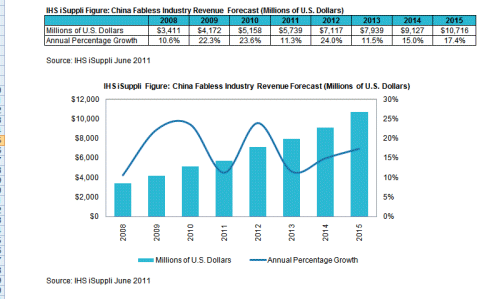China’s Fabless Market Set to Double by 2015
El Segundo, Calif., June 10, 2011—Driven by strong domestic demand and soaring exports, China’s fabless semiconductor market is on a high-growth trajectory, with revenue set to double from 2010 to 2015, new IHS iSuppli (NYSE: IHS) research indicates.
Operations by fabless semiconductor companies in China will generate $10.7 billion in revenue in 2015, up from $5.2 billion in 2010, as presented in the accompanying figure. The growth comes on top of a 23.6 percent expansion in 2010, with revenue rising from $4.2 billion in 2009. Revenue will reach $5.74 billion in 2011, up 11.3 percent from 2010.
“China’s fabless industry in 2010 benefited from the booming demand for semiconductors used in cell phones, as shipments last year of mobile handsets designed in China surged by nearly 60 percent,” said Vincent Gu, senior analyst for China research at IHS.

Capitalizing on such growth in 2010, leading Chinese fabless supplier Spreadtrum Communications designed a range of semiconductors for cell phones including core chipsets, radio frequency transceivers and total wireless solutions for mobile handsets. The company posted $346 million in revenue in 2010, making it the first fabless semiconductor supplier in the country to surpass the $300 million mark. Spreadtrum is likely to retain leadership in 2011 with revenue of more than $500 million.
Three C’s key to fabless growth in China
“To generate growth in the coming years, China’s fabless semiconductor companies are likely to focus on what IHS iSuppli calls the three C’s: China, Consumer and Convergence,” Gu said.
Fabless firms must emphasize the domestic Chinese technology industry, allowing local tech companies to cash in on the expansion of the burgeoning market. Fabless firms also need to leverage China’s home advantages, such as the vast demand within the country.
Moreover, China’s fabless semiconductor suppliers must focus on consumer electronics because the major characteristics of the consumer electronics market—including technology, price and quality—play to the strengths of Chinese chip designers.
On a third front, Chinese fabless suppliers now must engage in the convergence of features in their products, a trend driven by the growing popularity of smart phones and tablets. They also must pay attention to the changes to industries and business models wrought by the convergence of features in products.
Three more C’s for continued success
However, to take the next step and surpass their worldwide competitors, China’s fabless firms also may want to pay attention to three more C’s: Culture, Content and Contribution, Gu observed. The companies must accommodate and adjust to the differing cultures of overseas customers. They must learn more about end-content sectors that drive the growth of technology markets. And China’s fabless firms must take advantage of government contributions to the industry, given that Beijing has instituted a range of policies designed to improve the fabless industry in areas including investments, tax rates and capital investments.
Fabless foibles
Despite strong growth prospects for the fabless business, the industry faces several obstacles.
For one, penetrating the market for logic semiconductors is difficult. Another challenge is obtaining sufficient semiconductor manufacturing fab capacity, which has been a problem for the companies in the past. In the first half of 2010, foundry and assembly capacity alike was in a state of short supply, and capacity was difficult to obtain given the small size of domestic fabless suppliers.
The fabless firms also must contend with the semiconductor industry’s oligopolistic structure, with market share dominated by a small group of large competitors. The very small size of the fabless Chinese fabless companies makes it harder for them to compete with the worldwide giants.
A bright spot for the fabless industry remains the support it enjoys from the government, which launched a new policy this year on software and integrated circuit industry. The new policy is more flexible, and the Chinese fabless industry appears set on a fast track to growth in the future.
For more information on this topic, please see the IHS iSuppli report entitled: First, China, then the Globe: Aggressive Forecast Bodes Well for China’s Fabless IC Industry
Advertisement
Learn more about IHS iSuppli





